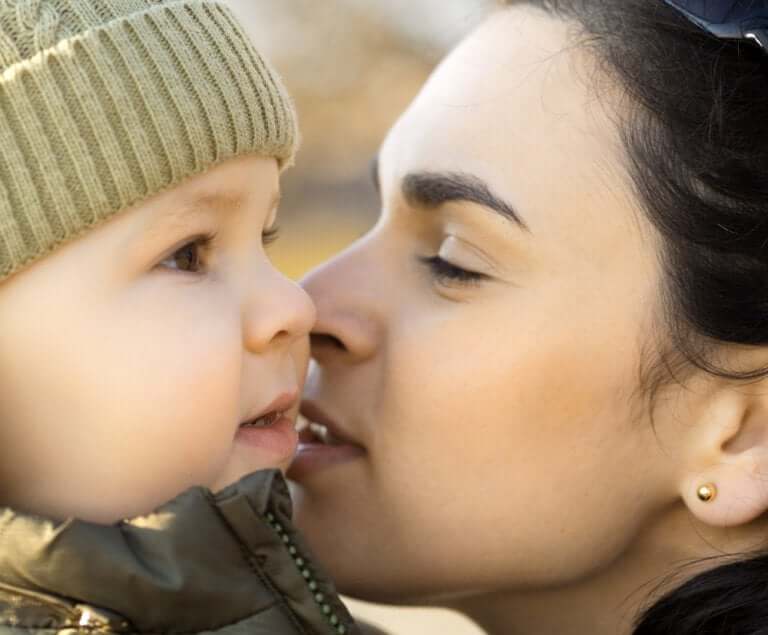What Is Secure Attachment Between Mother and Child?

Attachment is a bond that’s created between a baby and his or her caregivers. Normally, the attachment figures are the parents and it usually tends to be the mother. In this article, we’ll be focusing on the secure attachment between mother and child.
Caregivers have the role of providing for the basic needs of the newborn baby. We could say that attachment is essential for human survival, even though it doesn’t appear in the first months of a baby’s life.
In fact, it usually takes around seven or eight months to create a strong bond with the parent, and this is usually affirmed at one year of age.
The attachment theory
The psychologist John Bowlby studied childhood development, and this led him to develop the attachment theory. This theory is based on the need that every child has to maintain a loving, intimate and continuous relationship with a close person who provides them with protection and support.
According to this theory, there are four types of attachment:
- Anxious-avoidant attachment
- Secure attachment
- Anxious-ambivalent attachment
- Disorganized attachment

Secure attachment is the one that the parent must try to establish with their child. This is because it’s the only one that guarantees that the child will feel loved and cared for. As the child grows, they’ll be able to develop a good self-concept and a good concept of others. Furthermore, by maintaining this emotional relationship, potential physical and mental health problems can be prevented.
“Attachment theory is a way of conceptualizing the propensity of human beings to form strong emotional bonds with others and of extending the various ways of expressing emotions of distress, depression, or anger when they are abandoned or experience separation or loss.”
– John Bowlby –
Secure attachment in childhood
Secure attachment refers to the strong and stable emotional bond that develops between a mother and child. As soon as this relationship is established, the baby continually seeks proximity and contact with the attachment figure.
In fact, in these cases, when the child is less than one year old and the mother disappears from their sight, they often begin to cry and feel distressed. However, once a child is a year old, this situation changes.
The baby learns that, even if their mother isn’t there in some situations, she’ll always come back. In that way, the child starts developing more autonomy and independence.
However, in situations that the child perceives as threatening, they’ll still need the presence of the attachment figure in order to be able to explore their surroundings. This happens because the mother provides them with security and emotional support.
Characteristics of secure attachment
A mother who wants to create a secure attachment with her child needs to meet the following characteristics:
- Providing unconditional love
- Acting with sensitivity and affection
- Showing permanent availability
- Attending to the child’s demands
- Responding to different emotional states
Consequences of secure attachment
Establishing a secure attachment also has an impact on a person’s future life, and especially on their social relationships. These children have a positive attitude towards others, and show confidence and a desire to meet new people.

Furthermore, when they’re teenagers or adults, they tend to form intimate and lasting relationships based on love, empathy, support, mutual respect and trust.
Therefore, if you want to raise children who will integrate well into society, then you must make sure to give them all your love and support from day one.
In short…
“If we want an independent and confident child, we must try to establish a secure attachment with them. This implies being available, and understanding and attending to his needs as such.”
– Mariel Bonnefon –
Attachment is a bond that’s created between a baby and his or her caregivers. Normally, the attachment figures are the parents and it usually tends to be the mother. In this article, we’ll be focusing on the secure attachment between mother and child.
Caregivers have the role of providing for the basic needs of the newborn baby. We could say that attachment is essential for human survival, even though it doesn’t appear in the first months of a baby’s life.
In fact, it usually takes around seven or eight months to create a strong bond with the parent, and this is usually affirmed at one year of age.
The attachment theory
The psychologist John Bowlby studied childhood development, and this led him to develop the attachment theory. This theory is based on the need that every child has to maintain a loving, intimate and continuous relationship with a close person who provides them with protection and support.
According to this theory, there are four types of attachment:
- Anxious-avoidant attachment
- Secure attachment
- Anxious-ambivalent attachment
- Disorganized attachment

Secure attachment is the one that the parent must try to establish with their child. This is because it’s the only one that guarantees that the child will feel loved and cared for. As the child grows, they’ll be able to develop a good self-concept and a good concept of others. Furthermore, by maintaining this emotional relationship, potential physical and mental health problems can be prevented.
“Attachment theory is a way of conceptualizing the propensity of human beings to form strong emotional bonds with others and of extending the various ways of expressing emotions of distress, depression, or anger when they are abandoned or experience separation or loss.”
– John Bowlby –
Secure attachment in childhood
Secure attachment refers to the strong and stable emotional bond that develops between a mother and child. As soon as this relationship is established, the baby continually seeks proximity and contact with the attachment figure.
In fact, in these cases, when the child is less than one year old and the mother disappears from their sight, they often begin to cry and feel distressed. However, once a child is a year old, this situation changes.
The baby learns that, even if their mother isn’t there in some situations, she’ll always come back. In that way, the child starts developing more autonomy and independence.
However, in situations that the child perceives as threatening, they’ll still need the presence of the attachment figure in order to be able to explore their surroundings. This happens because the mother provides them with security and emotional support.
Characteristics of secure attachment
A mother who wants to create a secure attachment with her child needs to meet the following characteristics:
- Providing unconditional love
- Acting with sensitivity and affection
- Showing permanent availability
- Attending to the child’s demands
- Responding to different emotional states
Consequences of secure attachment
Establishing a secure attachment also has an impact on a person’s future life, and especially on their social relationships. These children have a positive attitude towards others, and show confidence and a desire to meet new people.

Furthermore, when they’re teenagers or adults, they tend to form intimate and lasting relationships based on love, empathy, support, mutual respect and trust.
Therefore, if you want to raise children who will integrate well into society, then you must make sure to give them all your love and support from day one.
In short…
“If we want an independent and confident child, we must try to establish a secure attachment with them. This implies being available, and understanding and attending to his needs as such.”
– Mariel Bonnefon –
All cited sources were thoroughly reviewed by our team to ensure their quality, reliability, currency, and validity. The bibliography of this article was considered reliable and of academic or scientific accuracy.
- Bowlby, J. (1969). Attachment, Vol. 1 of Attachment and loss. New York: Basic Books.
- Delgado, A. O., & Oliva Delgado, A. (2004). Estado actual de la teoría del apego. Revista de Psiquiatría y Psicología del Niño y del Adolescente, 4(1), 65-81.
- López, C. y Ramírez, M. (2005). Apego. Revista Chilena de Medicina Familiar, 6(1).
This text is provided for informational purposes only and does not replace consultation with a professional. If in doubt, consult your specialist.








